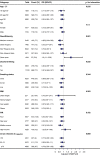Association between dietary calcium and depression among American adults: National health and nutrition examination survey
- PMID: 36845060
- PMCID: PMC9948022
- DOI: 10.3389/fnut.2023.1042522
Association between dietary calcium and depression among American adults: National health and nutrition examination survey
Abstract
Background: There is only limited evidence for an association between calcium (Ca) and depression, and the relationship was inconsistent. Therefore, the aim of this study was to assess the relationship between dietary Ca and the risk of depressive symptoms in individuals over the age of 18 in the US.
Methods: We extracted 14,971 participants from the US National Health and Nutrition Examination Survey (NHANES) 2007-2016 to probe their associations. Dietary Ca intake was measured through 24 h dietary recall method. Patients with the Patient Health Questionnaire-9 (PHQ-9) ≥ 10 scores were believed to have depressive symptoms. The association between dietary Ca and depressive symptoms was investigated using multivariate logistic regression, sensitivity analysis, and restricted cubic spline regression.
Results: In this study, 7.6% (1,144/14,971) of them had depressive symptoms. After adjusting for sex, age, race, poverty to income ratio (PIR), marital status, education, body mass index (BMI), caffeine intake, carbohydrates intake, total energy intake, smoking status, alcohol consumption, physical activity, diabetes, hypertension, severe cardiovascular disease (CVD), cancer, serum vitamin D, serum Ca, and Ca supplement, the adjusted ORs value [95% confidence interval (CI)] of depression for the lowest category (Q1 ≤ 534 mg/day) vs. Q2-Q4 of Ca intake were 0.83 (0.69-0.99), 0.97 (0.65-0.95), and 0.80 (0.63-0.98) with the p for trend (p = 0.014). The relationship between dietary Ca intake and depressive symptoms was linear (non-linear p = 0.148). None of the interactions were significant except among races (p for interaction = 0.001).
Conclusion: Association between dietary Ca and the prevalence of depressive symptoms in US adults. And Ca intake was negatively associated with the risk of depressive symptoms. As Ca intake increased, the prevalence of depressive symptoms decreased.
Keywords: National Health and Nutrition Examination Survey (NHANES); adults; calcium; depression; dietary calcium.
Copyright © 2023 Shen, Gu, Liu, Yang, Zheng and Jiang.
Conflict of interest statement
The authors declare that the research was conducted in the absence of any commercial or financial relationships that could be construed as a potential conflict of interest.
Figures



Similar articles
-
Association between vitamin K intake and depressive symptoms in US adults: Data from the National Health and Nutrition Examination Survey (NHANES) 2013-2018.Front Nutr. 2023 Mar 22;10:1102109. doi: 10.3389/fnut.2023.1102109. eCollection 2023. Front Nutr. 2023. PMID: 37032783 Free PMC article.
-
Body mass index modifies the relationship between dietary iron intake and depressive symptoms among adults: A national population-based cohort.J Affect Disord. 2023 Nov 1;340:907-913. doi: 10.1016/j.jad.2023.08.105. Epub 2023 Aug 22. J Affect Disord. 2023. PMID: 37619653
-
Association between dietary sugar intake and depression in US adults: a cross-sectional study using data from the National Health and Nutrition Examination Survey 2011-2018.BMC Psychiatry. 2024 Feb 8;24(1):110. doi: 10.1186/s12888-024-05531-7. BMC Psychiatry. 2024. PMID: 38326834 Free PMC article.
-
Association between dietary iron intake and hyperuricemia in U.S. adults: a cross-sectional study.BMC Public Health. 2024 Nov 1;24(1):3030. doi: 10.1186/s12889-024-20526-5. BMC Public Health. 2024. PMID: 39482656 Free PMC article.
-
Is selenium intake associated with the presence of depressive symptoms among US adults? Findings from National Health and Nutrition Examination Survey (NHANES) 2011-2014.Nutrition. 2019 Jun;62:169-176. doi: 10.1016/j.nut.2018.12.007. Epub 2018 Dec 21. Nutrition. 2019. PMID: 30921553
Cited by
-
Geriatric nutrition risk index in the prediction of all-cause and cardiovascular mortality in elderly hypertensive population: NHANES 1999-2016.Front Cardiovasc Med. 2023 Jul 3;10:1203130. doi: 10.3389/fcvm.2023.1203130. eCollection 2023. Front Cardiovasc Med. 2023. PMID: 37465450 Free PMC article.
-
The Nutrient-Skin Connection: Diagnosing Eating Disorders Through Dermatologic Signs.Nutrients. 2024 Dec 17;16(24):4354. doi: 10.3390/nu16244354. Nutrients. 2024. PMID: 39770975 Free PMC article.
-
Relationship between emotional eating and nutritional intake in adult women with overweight and obesity: a cross-sectional study.Nutr J. 2024 Oct 22;23(1):129. doi: 10.1186/s12937-024-01030-3. Nutr J. 2024. PMID: 39438830 Free PMC article.
-
Comparative analysis of the nutritional, physicochemical, and bioactive characteristics of Artemisia abyssinica and Artemisia arborescens for the evaluation of their potential as ingredients in functional foods.Food Sci Nutr. 2024 Aug 29;12(10):8255-8279. doi: 10.1002/fsn3.4431. eCollection 2024 Oct. Food Sci Nutr. 2024. PMID: 39479604 Free PMC article.
-
Trends in Calcium Intake among the US Population: Results from the NHANES (1999-2018).Nutrients. 2024 Mar 2;16(5):726. doi: 10.3390/nu16050726. Nutrients. 2024. PMID: 38474853 Free PMC article.
References
-
- World Health Organization,. Depression. (2021). Available online at: https://www.who.int/en/news-room/fact-sheets/detail/depression (accessed August 1, 2022).
LinkOut - more resources
Full Text Sources
Research Materials

